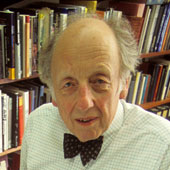Michael Henchman
 Professor of Chemistry Emeritus
Professor of Chemistry Emeritus
Degrees
Yale University, 1961, PhD
Profile
Michael Henchman studies the chemistry of ions in the gas phase.
At normal laboratory temperatures, molecules do not ionize in the gas phase. So ions play no role in normal chemical reactions in the gas phase. We make ions in the gas phase abnormally, by electron bombardment; we study their properties and reactions, and we apply these results to situations where ions are found naturally, for example, in solution and in interstellar space.
Superacidity
How can we identify the strongest acid? In solution, the answer depends on the solvent. In acetic acid solution, it is triflic acid CF3SO3H: in sulfuric acid solution, it is fluorosulfonic acid FSO3H. The paradox is resolved by measuring intrinsic acidity -- the energy needed to deprotonate an acid in the gas phase: HX --> H(+) + X(-). In this way, we have ordered the strengths of the superacids (the strongest is triflic).
Reaction within Reaction Intermediates
For example, for the acid/base reaction AH(+) + B --> A + H(+)B, we study the proton jump within the intermediate AH+.B --> A.H(+)B. For nucleophilic displacement, X(-) +CH3Y --> CH3X + Y(-), we study the Walden inversion within the intermediate X- .H3CY --> XCH3 .Y(-).
Anti-Arrhenius Kinetics
Reactions over barriers show Arrhenius-type kinetics with an activation energy equal to the height of the energy barrier. Paradoxically, reactions which show no energy barriers can also be slow, with rate constants increasing as the temperature decreases. Understanding "upside-down" kinetics, where reactions run fastest at absolute zero, is a major goal of my research.
Deuterated Molecules in Interstellar Space
Large and exotic molecules, such as HC9N, are being observed in the Milky Way. Furthermore the deuterium abundance in these molecules can be 1000 times larger than that on earth. From laboratory studies of isotopic fractionation, we seek to learn how these molecules are formed.
Selected Publications
"Proton Motion within Proton-Bound Dimers: H3O(+) .H2O <=> H2).H3)(+), NH4(+).NH3 <=> NH3.NH4(+) and CH5(+).CH4 <=> CH4.CH5(+). A Kinetic Model for Isotope-Exchange Reactions," Int. J. Mass Spectrom. Ion Processes 1991, 109, 105; with D. Smith and N.G. Adams.
"Isotope-Exchange Reactions as a Function of Temperature: Isotopic Fractionation in Interstellar Molecules," In Chemistry and Spectroscopy of Interstellar Molecules, D.K. Bohme, E. Herbst, N. Kaifu and S. Saito, Eds., University of Tokyo Press: Tokyo, 1992, pp. 251-253; with J.F. Paulson.
"Gas-Phase Reactions of Weak Brønsted Bases II(-), PO3(-), HSO4(-), FSO3(-), CF3SO3H. with Strong Brønsted Acids H2SO4, FSO3H, CF3SO3H. A Quantitative Intrinsic Superacidity Scale for the Sulfonic Acids XSO3H (X = HO, F, CF3)" J. Am. Chem. Soc. 1992, 114, 4299; with A.A. Viggiano, F. Dale, C.A. Deakyne and J.F. Paulson.
"Rate Constants and Their Temperature Dependences. A Kinetic Description Using Simple Model Potential-Energy Surfaces," Angew. Chem., to appear.